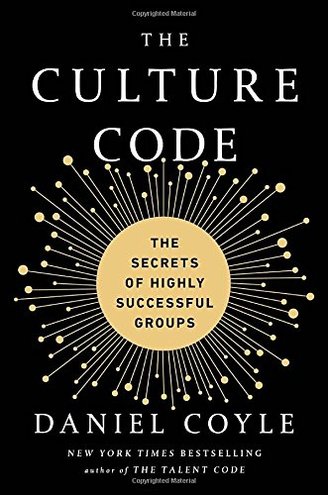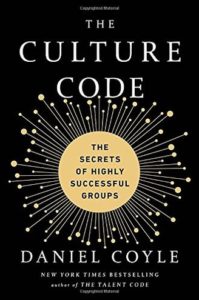In The Culture Code, Daniel Coyle goes inside some of the world’s most successful organizations—including the U.S. Navy’s SEAL Team Six, IDEO, Google and the San Antonio Spurs—and reveals what makes them tick. He demystifies the culture-building process by identifying three key skills that generate cohesion and cooperation, and explains how diverse groups learn to function with a single mind. Drawing on examples that range from Internet retailer Zappos to the comedy troupe Upright Citizens Brigade to a daring gang of jewel thieves, Coyle offers specific strategies that trigger learning, spark collaboration, build trust, and drive positive change. Coyle unearths helpful stories of failure that illustrate what not to do, troubleshoots common pitfalls, and shares advice about reforming a toxic culture. Combining leading-edge science, on-the-ground insights from world-class leaders, and practical ideas for action, The Culture Code offers a roadmap for creating an environment where innovation flourishes, problems get solved, and expectations are exceeded.
Culture is not something you are—it’s something you do. The Culture Code puts the power in your hands. No matter the size of your group or your goal, this book can teach you the principles of cultural chemistry that transform individuals into teams that can accomplish amazing things together.
Culture Code: Skill 1 – Build Safety | Skill 2 – Share Vulnerability | Skill 3 – Establish Purpose
BUILD SAFETY – keys to building safety:
- Close physical proximity, often in circles
- Profuse amounts of eye contact
- Physical touch (handshakes, fist bumps, hugs)
- Lots of short, energetic exchanges (no long speeches)
- High levels of mixing; everyone talks to everyone
- Few interruptions
- Lots of questions
- Intensive, active listening
- Sense of family
- Chemistry – it’s a paradoxical, powerful sensation
University of South Wales experiment (Nick)
- Jonathan makes it safe, then turns to the other people and asks, “Hey, what do you think of this?” or “How do you do that”.
- Jonathan doesn’t take charge or tell anyone what to do. He doesn’t strategize, motivate, or lay out a vision.
- Safer, not smarter…. Sense of family
The story of the good apples is surprising in two ways. First, we tend to think group performance depends on measurable abilities like intelligence, skill, and experience, not on a subtle pattern of small behaviors.
“These ads suck” – Larry Page, 2002
Adwords weren’t working. Competition with Overture.
Jeff Dean was one of the last people in Google’s office to see Page’s note. He worked in Search, which was a different area of the company, and he was more than busy navigating his own urgent problems. He did not ask permission or tell anyone; he simply dove in working Saturday and Sunday until 5am Monday morning. The year following, Google’s profits went from $6million to $99million.
- No ego from Jeff. Wasn’t that big of a deal to him.
- Google was interacting just like the kindergartners in the spaghetti-marshmallow challenge… They did not manage their status or worry about who was in charge. Their small building produced high levels of proximity and face-to-face interaction. Page’s technique of igniting whole-group debates around solving tough problems sent a powerful signal of identity and connection, as did the no-holds-barred hockey games and wide-open Friday forums.
SHARE VULNERABILITY – keys to sharing vulnerability:
- Make sure the leader is vulnerable first and often
- Laszlo Bock, former head of People analytics recommends that leaders ask their people three questions: 1. What is one thing that I currently do that you’d like me to continue to do? 2. What is one thing that I don’t currently do frequently enough that you think I should do more often? 3. What can I do to make you more effective?
- Overcommunicate expectations
- IDEO CEO Tim Brown incessantly repeats his mantra that the more complex the problem, the more help you need to solve it.
- Deliver the negative stuff in person
- Informal rule: If you have negative news or feedback to give someone – even as small as a rejected item on an expense report – you are obligated to deliver that news face to face.
- Chicago Cubs coach Joe Maddon keeps a glass bowl filled with slips of paper, each inscribed with the name of an expensive wine. When a player violates a team rule, he asks them to draw a slip of paper out of the bowl, purchase that wine, and uncork it with their manager. This links the act of discipline to the act of reconnection.
- When forming new groups, focus on two critical moments
- 1. The first vulnerability and 2. The first disagreement
- Listen like a trampoline
- The most effective listeners aren’t passive sponges. They are active responders, absorbing what the other other person gives, supporting them, and adding energy to help the conversation gain velocity and altitude.
- In conversations, resist the temptation to reflexively add value
- The most important part of creating vulnerability is not in what you say, but what you don’t say. Skilled listeners do not interrupt with cliche’ phrases as they understand its not about them. Try saying “say more about that.”
- Use candor-generating practices like AARs, BrainTrusts, and Red Teaming
- See below
- Aim for candor, avoid brutal honesty
- Embrace the discomfort
- Align language with action
- At Pixar, they do not offer “notes” on early versions of films; they “plus” them by offering solutions to problems. This reinforces the groups shared identify.
- Build a wall between performance review and professional development
- Use flash mentoring
- Just like traditional mentoring but not over months or years, but a few hours.
- Make the leader occasionally disappear
Navy Seals AAR (after action review):
- What were our intended results?
- What were our actual results?
- What caused our results?
- What will we do the same next time?
- What will we do differently?
BAR (before action review):
- What are our intended results?
- What challenges can we anticipate?
- What have we or others learned from similar situations?
- What will make us successful this time?
ESTABLISH PURPOSE – keys to establishing purpose:
- Name and rank your priorities
- In order to move toward a target, you must first have a target.
- Most successful groups prioritize their in-group relationships at the top.
- Be ten times as clear about your priorities as you think you should be
- Measure what really matters
- Use artifacts
- Focus on bar-setting behaviors

